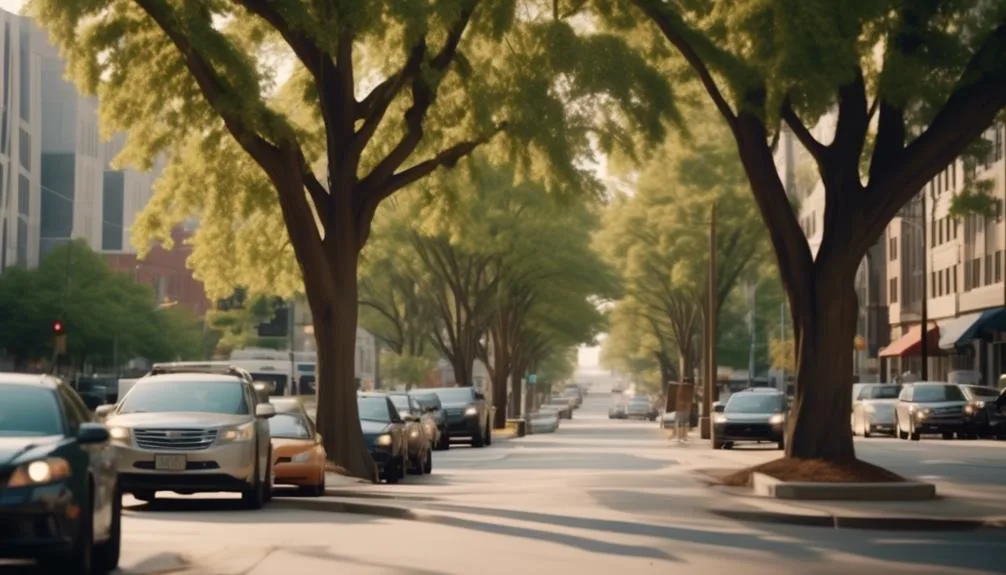Can Hickory Trees Thrive in Cities?
Ever wondered if hickory trees can survive in the urban jungle? The idea may sound unlikely, but it's worth exploring. The unique traits of hickory trees and the challenges of city life make for an interesting discussion.
Surprisingly, there are factors that might change your perspective on this matter. If you're seeking a touch of nature amidst city life, the potential for hickory trees to flourish in urban areas could be an intriguing topic to consider.
Suitable Urban Environments for Hickory Trees
When choosing suitable urban environments for hickory trees, consider the presence of ample sunlight and well-draining soil to promote healthy growth and longevity.
Hickory trees thrive in areas with abundant sunlight, as it's essential for their photosynthesis and overall health. The tree canopy in urban settings should allow for sufficient sunlight to reach the hickory trees and support their growth.
Additionally, soil quality plays a crucial role in the successful cultivation of hickory trees in urban areas. Well-draining soil is vital to prevent waterlogging, which can be detrimental to hickory trees, as they prefer soil that's moist but not waterlogged.
Challenges of Growing Hickory Trees in Urban Areas
To successfully cultivate hickory trees in urban areas, you must navigate through the challenges posed by limited space and urban pollution, which can impact their growth and overall health.
Urban pollution, including vehicle emissions and industrial by-products, can pose a significant threat to hickory trees. The high levels of pollutants in the air and soil can hinder the trees' ability to photosynthesize and absorb nutrients, ultimately affecting their overall health.
Additionally, the limited root space in urban environments presents a major challenge. Hickory trees require ample room for their roots to spread and access essential nutrients and water. However, in urban areas, competition for space with buildings, sidewalks, and other infrastructure can restrict the root development of hickory trees, leading to stunted growth and increased susceptibility to environmental stressors.
Best Practices for Planting Hickory Trees in Urban Settings
When preparing to plant hickory trees in urban settings, carefully consider the surrounding environment and accessibility to essential resources. Urban landscaping presents unique challenges, but with the right approach, hickory trees can thrive and contribute to tree diversity in the area.
Here are some best practices for planting hickory trees in urban settings:
- Select tree species that are well-suited to urban environments, such as Shagbark Hickory or Shellbark Hickory.
- Ensure the planting site has adequate space for the tree to reach its full size without interfering with buildings or infrastructure.
- Consider the soil quality and drainage to provide the hickory tree with a healthy growing environment.
- Regularly monitor the tree for signs of stress or disease, and provide necessary care and maintenance.
- Engage with local community groups or urban forestry programs to receive guidance and support for planting and maintaining hickory trees.
Benefits of Having Hickory Trees in Urban Environments
Having discussed the best practices for planting hickory trees in urban settings, it's now essential to understand the numerous benefits these trees can bring to urban environments.
Hickory trees have a significant environmental impact, as they help purify the air by absorbing pollutants and releasing oxygen. Their extensive root systems also aid in preventing soil erosion and stormwater runoff, contributing to overall environmental health.
Moreover, hickory trees promote community engagement by providing a natural gathering space for residents to enjoy recreational activities, fostering a sense of unity and connection. Additionally, their beauty and shade offer a pleasant urban landscape, attracting wildlife and providing a habitat for birds and small animals.
Maintenance Tips for Urban Hickory Tree Growth
Consider ensuring proper care and regular maintenance for healthy hickory tree growth in urban settings. Pruning techniques play a crucial role in shaping the tree's structure and promoting optimal growth.
Regularly inspect the tree for dead, damaged, or diseased branches, and promptly remove them to enhance overall health.
Additionally, proper soil quality is essential for urban hickory trees. Ensure the soil is well-draining and rich in organic matter to support healthy root development. Mulching around the base of the tree can help retain moisture and regulate soil temperature.
Lastly, consider consulting with a professional arborist to develop a tailored maintenance plan for your urban hickory trees.
- Regularly inspect and prune the tree for dead, damaged, or diseased branches.
- Ensure the soil is well-draining and rich in organic matter.
- Mulch around the base of the tree to retain moisture and regulate soil temperature.
- Consider consulting with a professional arborist for a tailored maintenance plan.
Conclusion
Incorporating hickory trees into urban areas is achievable with the right selection, care, and attention. By choosing suitable species, nurturing their growth, and maintaining them properly, urban landscapes can benefit from the shade, wildlife support, and vibrant autumn hues that hickory trees offer.
Embracing these trees not only enhances the urban environment but also enriches the community's connection with nature.
Mark Hoffman is a dedicated arborist and tree care specialist with over a decade of experience. His love for trees began when he visited Yosemite National Park as a teenager and was awestruck by the giant sequoias. Mark pursued his passion by studying forestry at Michigan Technological University, where he earned a Bachelor of Science degree.
Since then, he has worked tirelessly in the field of arboriculture, helping to preserve and protect trees in his community. His expertise and dedication have made him a respected leader in the industry and a valuable resource for anyone seeking advice on tree care.
